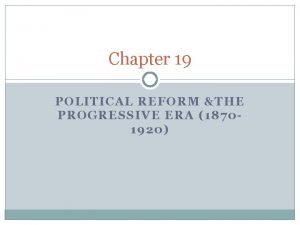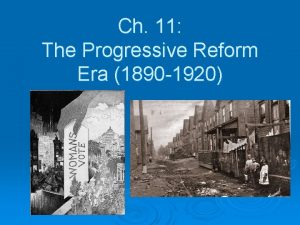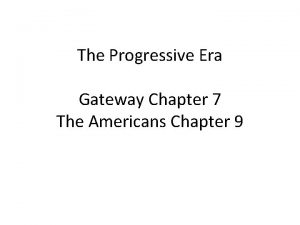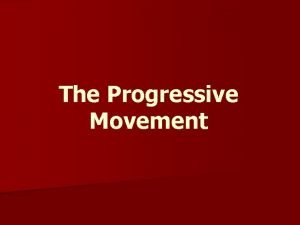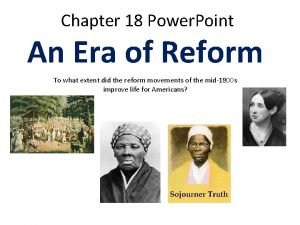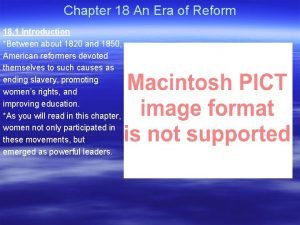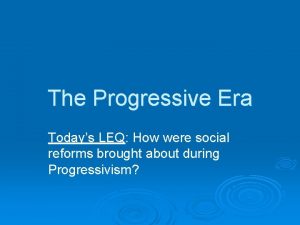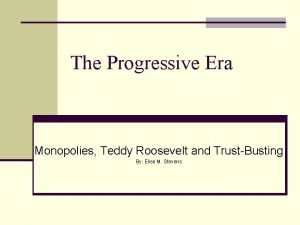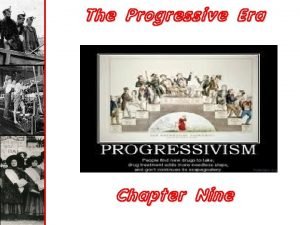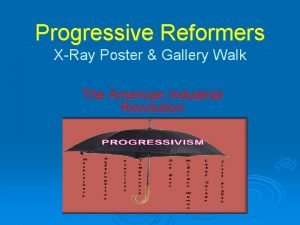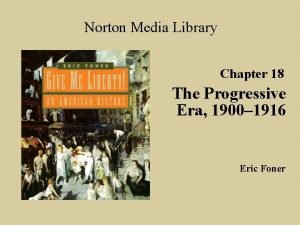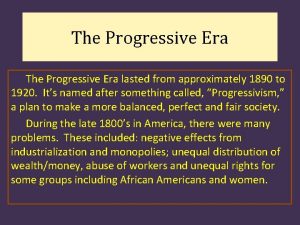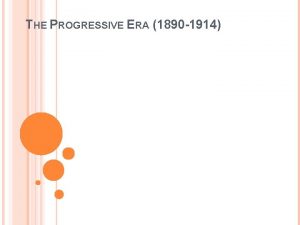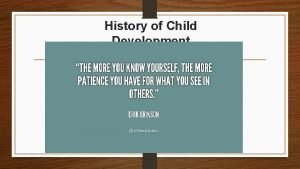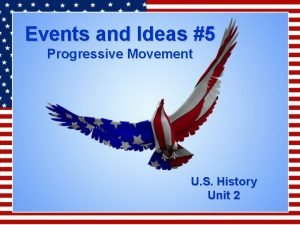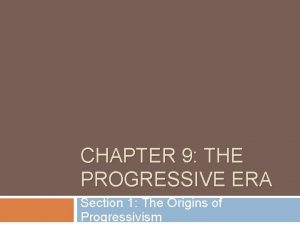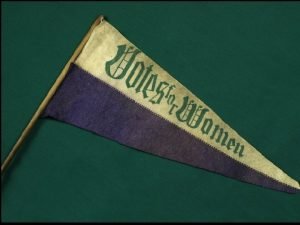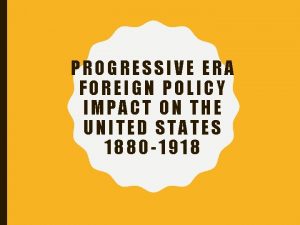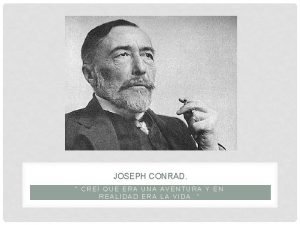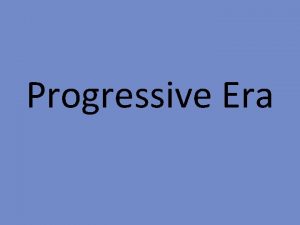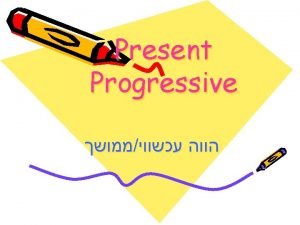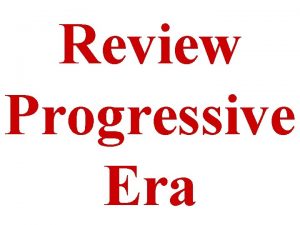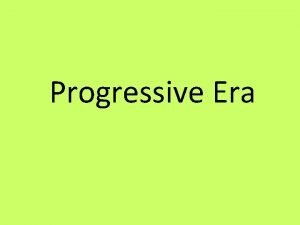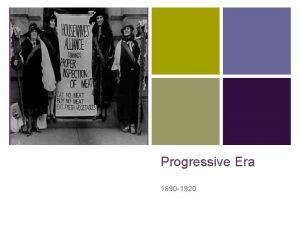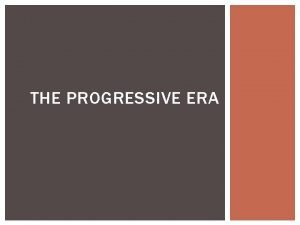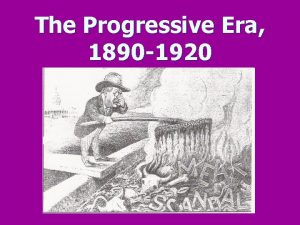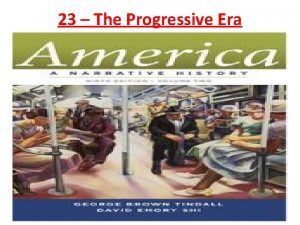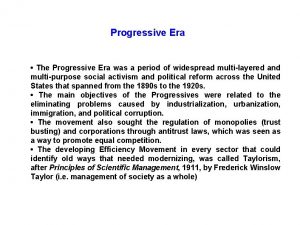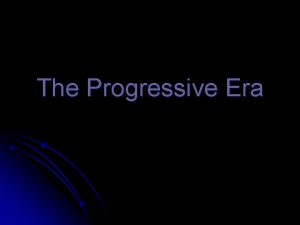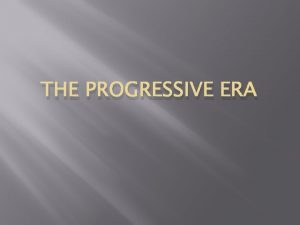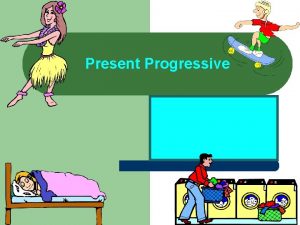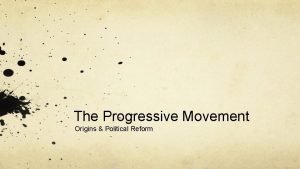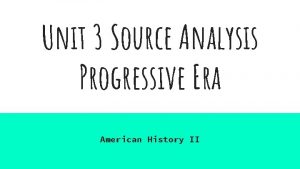THE PROGRESSIVE ERA US History American Reform Tradition


















































- Slides: 50

THE PROGRESSIVE ERA US History

American Reform Tradition Abolition Women’s rights Unions Populists

Problems from the Gilded Age (you should be able to describe specific problems for each topic) Big Business/Monopolies Working Conditions Urban Life Government Corruption Inequality

The Progressives Middle class – squeezed out by the rich on one side (oligarchy? ) and the poor on the other (mass uprising? ) Many women Muckrakers/Reporters (expose problems) Politicians Reformers

The Progressive Goals expose problems use government as a tool to fix problems rejection of pure winner take all capitalism efficiency & science

Research Directions You will be responsible for researching information on the Progressive Era reformers. These reformers attempted to fix the problems created by the Age of Industry. All students will be responsible for reading all of the information on all of the Progressive reformers and completing the assigned handout. � � � Fill in the first column on the problems (use readings, excerpts and knowledge of American history) Fill in the middle column what the reformer did about the problem Fill in the final column by writing down what reforms were passed in response to the Progressives action (not all problems were solved, some apply to more than one reformer)

Progressive Reformers Working Conditions: John Spargo, Upton Sinclair Urban Problems: Jacob Riis, Jane Addams, Frances Willard, Margaret Sanger Monopolies: Ida Tarbell Inequality: Carrie Chapman Catt, Alice Paul, Ida Wells, Booker T. Washington, W. E. B. Du. Bois

John Spargo – Child Labor Author of The Bitter Cry of the Children Work in the coal breakers is exceedingly hard and dangerous. Crouched over the chutes, the boys sit hour after hour, picking out the pieces of slate and other refuse from the coal as it rushes past to the washers. From the cramped position they have to assume, most of them become more or less deformed and bent-backed like old men. The coal is hard, and accidents to the hands, such as cut, broken, or crushed fingers, are common among the boys. Sometimes there is a worse accident: a terrified shriek is heard, and a boy is mangled and torn in the machinery, or disappears in the chute to be picked out later smothered and dead. Clouds of dust fill the breakers and are inhaled by the boys, laying the foundations for asthma and miners consumption. I once stood in a breaker for half an hour and tried to do the work a twelve year old boy was doing day after day, for ten hours at a stretch, for sixty cents a day. The gloom of the breaker appalled me. Outside the sun shone brightly, the air was (clear), and the birds sang in chorus with the trees and the rivers. Within the breaker there was blackness, clouds of deadly dust enfolded everything, the harsh, grinding roar of the machinery and the ceaseless rushing of coal through the chutes filled the ears. I tried to pick out the pieces of slate from the hurrying stream of coal, often missing them; my

John Spargo – Child Labor Author of The Bitter Cry of the Children

John Spargo – Child Labor Author of The Bitter Cry of the Children

Reaction to The Bitter Cry of the Children 38 states passed child labor laws in 1912 alone. Keating Owen Act (1916) - law passed by Congress regulating child labor for any company involved in interstate trade minimum age of 14 in general � minimum age of 16 for mining or night work � eight hour maximum per day � Hammer v. Dagenhart (1918) – declared Keating Owen Act unconstitutional; not addressed again at the federal level until 1938

Upton Sinclair Author of The Jungle Upton Sinclair wrote the book The Jungle. It was intended to show the horrible working conditions of the meat packing industry, but had a greater impact on the nation by exposing the disgusting food Americans were eating.

Upton Sinclair Author of The Jungle EXCERPT #1: With one member trimming beef in a cannery, and another working in a sausage factory, the family had a first-hand knowledge of the great majority of Packingtown swindles. For it was the custom, as they found, whenever meat was so spoiled that it could not be used for anything else, either to can it or else to chop it up into sausage. With what had been told them by Jonas, who had worked in the pickle rooms, they could now study the whole of the spoiled-meat industry on the inside, and read a new and grim meaning into that old Packingtown jest that they use everything of the pig

Upton Sinclair Author of The Jungle EXCERPT #2: Jonas had told them how the meat would often be found sour, and how they would rub it up with soda to take away the smell, and sell it to be eaten on free-lunch counters; also of all the miracles of chemistry which they performed, giving to any sort of meat, fresh or salted, whole or chopped, any color and any flavor and any odor they chose…And yet, in spite of this, there would be hams found spoiled, some of them with an odor so bad that a man could hardly bear to be in the room with them. Also, after the hams had been smoked, there would be found some that had gone to the bad. Formerly these had been sold as "Number Three Grade, " but later on some ingenious person had hit upon a new device, and now they would extract the bone, about which the bad part generally lay, and insert in the hole a white-hot iron. After this invention there was no longer Number One, Two, and Three Grade, there was only Number One Grade. The packers were always originating such schemes, they had what they called "boneless hams, " which were all the odds and ends of pork stuffed into casings; and "California hams, " which were the shoulders, with big knuckle joints, and nearly all the meat cut out; and fancy "skinned hams, " which were made of the oldest hogs, whose skins

Reaction to The Jungle The public was disgusted by The Jungle. President Roosevelt questioned Sinclair’s motives because of his socialist background. Roosevelt had the government investigate further and when he read the Neil-Reynolds Report, he realized the problem was worse than Sinclair reported. Fearing national panic and severe economic repercussions, Roosevelt used all of his power to push Congress to pass new legislation. • • Pure Food and Drug Act - required accurate labels on food and drugs Meat Inspection Act - allowed federal inspectors into meat packing plants

Jacob Riis Author of How the Other Half Lives

Jacob Riis Author of How the Other Half Lives Lest anybody flatter himself with the notion that these were evils of a day that is happily past and may safely be forgotten, let me mention here three very recent instances of tenement-house life that came under my notice. One was the burning of a rear house in Mott Street, from appearances one of the original tenant-houses that made their owners rich. The fire made homeless ten families, who had paid an average of $5 a month for their mean little cubby-holes. The owner himself told me that it was fully insured for $800, though it brought him in $600 a year rent. He evidently considered himself especially entitled to be pitied for losing such valuable property. Another was the case of a hard-working family of man and wife, young people from the old country, who took poison together in a Crosby Street tenement because they were "tired. " There was no other explanation, and none was needed when I stood in the room in which they had lived. It was in the attic with sloping ceiling and a single window so far out on the roof that it seemed not to belong to the place at all. With scarcely room enough to turn around in they had been compelled to pay five dollars and a half a month in advance. There were four such rooms in that attic, and together they brought in as much as many a handsome little cottage in a pleasant part of Brooklyn. The third instance was that of a colored family of husband, wife, and baby in a wretched rear rookery in West Third Street. Their rent was eight dollars and a half for a single room on the top-story, so small that I was unable to get a photograph of it even by placing the camera outside the open door. Three short steps across either way would have measured its full extent.

Jacob Riis Author of How the Other Half Lives

Jacob Riis Author of How the Other Half Lives

Reaction to How the Other Half Lives Riis’ book, published in 1890, had an impact on many politicians including the young NYC police commissioner Theodore Roosevelt. Riis’ photos and writings contributed to political pressure to improve New York City housing codes and resulted in concrete improvements in the tenements. The city adopted new building codes that required more light, less crowding and, eventually, heat and plumbing. � New York State Tenement Act (1901) – mandated better light, ventilation, and toilets

Jane Addams Founder of the Hull House

Jane Addams Founder of the Hull House When Jane Addams and Ellen Gates Starr first opened Hull-House in 1889, they had very modest goals. In the 1890 s, Hull-House was located in the midst of a densely populated urban neighborhood peopled by Italian, Irish, German, Greek, Bohemian, and Russian and Polish Jewish immigrants. They imagined a place to offer art and literary education to their less fortunate neighbors. The role of Hull-House, however, quickly grew beyond what either Gates or Addams could have imagined and continuously evolved to meet the needs of their neighbors. The residents of Hull-House, at the request of the surrounding community, began to offer practical classes that might help the new immigrants become more integrated into American society, such as English language, cooking, sewing and technical skills, and American government. The residents were the women and men who chose to live at Hull-House; they paid rent and contributed to the activities and services that the Settlement was committed to providing to their neighbors. These services included, but were not limited to, a nursery and a kindergarten, a public kitchen, and access to public baths and a playground. Hull-House became not only a cultural center with music, art, and theater offerings, but also a safe haven and a place where the immigrants living on Chicago's Near West Side could find companionship and support and the assistance

Jane Addams Founder of the Hull House The residents of Hull-House formed an impressive group, including Jane Addams, Ellen Gates Starr, Florence Kelley, Dr. Alice Hamilton, Julia Lathrop, Sophonisba Breckinridge, and Grace and Edith Abbott. From their experiences in the Hull-House neighborhood, the Hull. House residents and their supporters forged a powerful reform movement. Among the projects that they helped launch were the Immigrants' Protective League, the Juvenile Protective Association, the first juvenile court in the nation, and a Juvenile Psychopathic Clinic (later called the Institute for Juvenile Research). Through their efforts, the Illinois Legislature enacted protective legislation for women and children in 1893. With the creation of the Federal Children's Bureau in 1912 and the passage of a federal child labor law in 1916, the Hull-House reformers saw their efforts expanded to the national level.

Frances Willard was the leader of the Women’s Christian Temperance Movement (WCTU). She hoped to prohibit alcohol in the United States because she wanted to protect the home and the Christian way of life. Willard supported the prohibition of alcohol because she felt it led to domestic abuse, financial ruin, and industrial accidents.

Frances Willard Prays in a Saloon The leader asked the saloon keeper if we might enter and he declined or else a prayer meeting would have occurred inside his door. A sorrowful old lady whose only son had gone through ruin in that very death trap, knelt on the cold, moist pavement and offered a prayer. At a signal we moved on and the next saloonkeeper permitted us to enter. I had no more idea of the inward appearance of a saloon than if there had been no such place on earth. I knew nothing of the heavy bar, barrels, sawdust covered floors, nor the abundant fumes, sickening to healthful nostrils. In the bar were a crowd of unwashed, unkempt, hard looking drinking men. I prayed as I never had in my life. The next day I went on to the West and within a week I had been made president of the Chicago W. C. T. U.

Reaction to the Temperance Movement The WCTU’s efforts combined World War I (didn’t want to waste resources/anti German beer) resulted in the 18 th Amendment being added to the Constitution in 1919. It banned the sale, manufacture or transportation of alcohol. Within a few years, there was widespread resistance to the measure and in 1933, the 18 th Amendment became the only amendment to be repealed by a later amendment, the 21 st.

Margaret Sanger fought for women to have the right to acquire and use birth control. It was a long struggle over most of the 1900 s for Sanger and her organization.

Gloria Steinham (1960 s feminist leader) on Margaret Sanger (Part I) The movement she started will grow to be, a hundred years from now, the most influential of all time, " predicted futurist and historian H. G. Wells in 1931. "When the history of our civilization is written, it will be a biological history, and Margaret Sanger will be its heroine. ” Though this prophecy of nearly 70 years ago credited one woman with the power that actually came from a wide and deep movement of women, no one person deserves it more. Now that reproductive freedom is becoming accepted and conservative groups are fighting to maintain control over women's bodies as the means of reproduction, Sanger's revolution may be even more controversial than during her 50 -year career of national and international battles. Her experience can teach us many lessons. She taught us, first, to look at the world as if women mattered. Born into an Irish working-class family, Margaret witnessed her mother's slow death, worn out after 18 pregnancies and 11 live births. While working as a practical nurse and midwife in the poorest neighborhoods of New York City in the years before World War I, she saw women deprived of their health, sexuality and ability to care for children already born. Contraceptive information was so suppressed by clergy-influenced, physician-accepted laws that it was a criminal offense to send it through the mail. Yet the educated had access to such information and could use subterfuge to buy "French" products, which were really condoms and other barrier methods, and "feminine hygiene" products, which were really spermicides.

Gloria Steinham on Margaret Sanger (Part II) It was this injustice that inspired Sanger to defy church and state. In a series of articles called "What Every Girl Should Know, " then in her own newspaper The Woman Rebel and finally through neighborhood clinics that dispensed woman-controlled forms of birth control (a phrase she coined), Sanger put information and power into the hands of women. While in Europe for a year to avoid severe criminal penalties, partly due to her political radicalism, partly for violating postal obscenity laws, she learned more about contraception, the politics of sexuality and the commonality of women's experience. Her case was dismissed after her return to the States. Sanger continued to push legal and social boundaries by initiating sex counseling, founding the American Birth Control League (which became, in 1942, the Planned Parenthood Federation of America) and organizing the first international population conference. Sanger was past 80 when she saw the first marketing of a contraceptive pill, which she had helped develop. But legal change was slow. It took until 1965, a year before her death, for the Supreme Court to strike down a Connecticut law that prohibited the use of contraception, even by married couples. Extended to unmarried couples only in 1972, this constitutionally guaranteed right to privacy would become as important to women's equality as the vote. In 1973 the right to privacy was extended to the abortion decision of a woman and her physician, thus making abortion a safe and legal alternative.

Ida Tarbell Author of The History of Standard Oil Ida Tarbell’s father was run out of business by John Rockefeller. She wrote a book The History of Standard Oil which exposed the corrupt practices of the oil monopoly.

Ida Tarbell The History of Standard Oil Rockefeller’s Rise: The strides the firm of Rockefeller & Andrews made after the former went into it were attributed, for three or four years, mainly to [his] extraordinary capacity for bargaining and borrowing. Then its chief competitors began to suspect something. Rockefeller might get his oil cheaper now and then, they said, but he could not do it often. He might make close contracts for which they had neither the patience nor the stomach. He might have an unusual mechanical and practical genius in his partner. But these things could not explain all. They believed they bought, on the whole, almost as cheaply as he, and they knew they made as good oil and with as great, or nearly as great, economy. He could sell at no better price than they. Where was his advantage? There was but one place where it could be, and that was in transportation.

Ida Tarbell The History of Standard Oil The South Improvement Company Scheme: For several days an uneasy rumor had been running up and down the Oil Regions. Freights were going up. Now an advance in a man's freight bill may ruin his business; more, it may mean the ruin of a region. On the morning of February 26, 1872, the oil men read in their morning papers that the rise which had been threatening had come; moreover, that all members of the Standard Oil Company were exempt from the advance. At the news, all of Oildom rushed into the streets. Nobody waited to find out his neighbor's opinion. On every lip there was but one word, and that was "conspiracy. "For weeks the whole body of oil men abandoned regular business and surged from town to town intent on destroying the "Monster, " the "Forty Thieves, " the "great Anaconda, " as they called the mysterious Standard Oil Company.

Reaction to The History of Standard Oil From the New York Times on Standard Oil of NJ v. US (1911) The Department of Justice filed a federal antitrust lawsuit against Standard in 1909, contending that the company restrained trade through its preferential deals with railroads, its control of pipelines and by engaging in unfair practices like price-cutting to drive smaller competitors out of business. The Supreme Court ruled against Standard “on the ground that it is a combination in unreasonable restraint of inter. State commerce, ” The New York Times explained, adding that the court “thus definitely reads the word ‘unreasonable’ into the law. ” The court’s decision forced Standard to break into 34 independent companies spread across the country and abroad. Many of these companies have since split, folded or merged; today, the primary descendants of Standard include Exxon. Mobil, Chevron and Conoco. Phillips.

Women’s Suffrage Prior to the 19 th Amendment

Women’s Rights Cartoons

Carrie Chapman Catt continued the work of Susan Anthony and Elizabeth Cady Stanton as the head of the National American Women’s Suffrage Association (NAWSA). After 1900, she led the organization and lobbied government to support an amendment for women’s suffrage. During World War I she supported the war effort in order to go along with the patriotism of the time. This attitude was contradicted by Alice Paul.

Alice Paul believed that Catt and NAWSA’s tactics weren’t aggressive enough. She formed the National Women’s Party (NWP). They protested outside the White House during World War I to demand immediate suffrage. They appealed to Wilson’s calls to make the world “safe for democracy” to include

Alice Paul

Alice Paul Despite their non-violent methods, many of the protestors were arrested outside the White House and taken to prison. To protest the jailing and the prison conditions, Alice Paul started a hunger strike. She was eventually force fed and the issue became a national story. President Wilson reluctantly came to side with the women’s suffrage protestors. Paul was released from prison. In 1920, the 19 th Amendment was added to the Constitution formally granting all women the right to vote after many, many years of protest for women’s suffrage. The fight for women’s rights continues to this day.

Ida Wells Barnett In March of 1892, Ida B. Wells, a journalist and former Memphis school teacher, started a crusade against lynching after three friends of hers were brutally murdered by a Memphis mob. Tom Moss and two of his friends, Calvin Mc. Dowell and Henry Stewart, were arrested for defending themselves against an attack on Moss' store. Moss was a highly respected figure in the black community, a postman as well as the owner of a grocery store. A white competitor, enraged that Moss had drawn away his black customers, hired some off-duty deputy sheriffs to destroy the store. Moss and his friends, not knowing the men were deputies, resisted. A gun battle broke out and several deputies were wounded. Moss, his two friends, and one hundred other black supporters were arrested. Several nights later, masked vigilantes dragged Moss and his two friends from their cells, took them to a deserted railroad yard, and shot them to death. Enraged by their deaths, Wells lashed out at the refusal of Memphis police to arrest the well known killers. She encouraged blacks to protest with boycotts of white-owned stores and public transportation. The lynchings were a turning point in Ida B. Wells' life. She began to investigate and reveal the real motivations that lay behind lynching. Like many middle-class African Americans, Wells had accepted the myth that only poor blacks were lynched for heinous crimes. Wells was now shocked into recognizing that even innocent middle-class black people could be targets. (PBS: Jim Crow Stories)

Ida Wells Barnett “Lynch Law in America” The Arena (1900) The alleged menace of universal suffrage having been avoided by the absolute suppression of the negro vote, the spirit of mob murder should have been satisfied and the butchery of negroes should have ceased. But men, women, and children were the victims of murder by individuals and murder by mobs, just as they had been when killed at the demands of the "unwritten law" to prevent "negro domination. " Negroes were killed for disputing over terms of contracts with their employers. If a few barns were burned some colored man was killed to stop it. If a colored man resented the imposition of a white man and the two came to blows, the colored man had to die, either at the hands of the white man then and there or later at the hands of a mob that speedily gathered. If he showed a spirit of courageous manhood he was hanged for his pains, and the killing was justified by the declaration that he was a "saucy nigger. " Colored women have been murdered because they refused to tell the mobs where relatives could be found for "lynching bees. " Boys of fourteen years have been lynched by white representatives of American civilization. In fact, for all kinds of offenses--and, for no offenses--from murders to misdemeanors, men and women are put to death without judge or jury; so that, although the political excuse was no longer necessary, the wholesale murder of human beings went on just the same. A new name was given to the killings and a new excuse was invented for so doing. In 1892, when lynching reached high-water mark, there were 241 persons lynched

Booker T. Washington On September 18, 1895, African. American spokesman and leader Booker T. Washington spoke before a predominantly white audience at the Cotton States and International Exposition in Atlanta. His Atlanta Compromise address, as it came to be called, was one of the most important and influential speeches in American history. Washington soothed his listeners concerns about blacks by claiming that his race would be content itself with living by the productions of our hands.

Booker T. Washington’s Atlanta Compromise Speech “To those of my race who depend on bettering their condition in a foreign land or who underestimate the importance of cultivating friendly relations with the Southern white man, who is their next-door neighbor, I would say: “Cast down your bucket where you are” cast it down in making friends in every manly way of the people of all races by whom we are surrounded. Cast it down in agriculture, mechanics, in commerce, in domestic service, and in the professions. And in this connection it is well to bear in mind that whatever other sins the South may be called to bear, when it comes to business, pure and simple, it is in the South that the Negro is given a man’s chance in the commercial world. Our greatest danger is that in the great leap from slavery to freedom we may overlook the fact that the masses of us are to live by the productions of our hands, and fail to keep in mind that we shall prosper in proportion as we learn to dignify and glorify common labor, and put brains and skill into the common occupations of life. No race can prosper till it learns that there is as much dignity in tilling a field as in writing a poem. It is at the bottom of life we must begin, and not at the top. Nor should we permit our grievances to

Booker T. Washington - The Tuskegee Institute To train African-Americans the skills they needed to develop their economic standing, Washington founded the Tuskegee Institute to teach blacks vocational skills.

George Washington Carver The most famous member of Tuskegee was George Washington Carver who came up with many ideas that revolutionized southern farming including crop rotation and hundreds of different uses for various crops.

W. E. B. Du. Bois WEB Du. Bois renounced Washington’s policies which he saw as accommodating to white Americans. He started the Niagara Movement which demanded full immediate equality for African Americans. This evolved into the National Association for the Advancement of Colored People (NAACP) in 1909.

Du. Bois’ Niagara Movement Speech The men of the Niagara Movement coming from the toil of the year’s hard work and pausing a moment from the earning of their daily bread, turn toward the nation and again ask in the name of ten million the privilege of a hearing. In the past year the work of the Negro hater has flourished in the land. Step by step the defenders of the rights of American citizens have retreated. The work of stealing the black man’s ballot has progressed and the fifty and more representatives of stolen votes still sit in the nation’s capital. Discrimination in travel and public accommodation has so spread that some of our weaker brethren are actually afraid to thunder against color discrimination as such and are simply whispering for ordinary decencies. Against this the Niagara Movement eternally protests. We will not be satisfied to take one jot or title less than our full manhood rights. We claim for ourselves every single right that belongs to a freeborn American, political, civil and social; and until we get these rights we will never cease to protest and assail the ears of America. The battle we wage is not for ourselves alone but for all true Americans. It is a fight for ideals, lest this, our common fatherland, false to its founding, become in truth the land of the thief and the home of the Slave a byword and a hissing among the nations for its sounding pretensions and pitiful accomplishment

NAACP Mission Statement The mission of the National Association for the Advancement of Colored People is to ensure the political, educational, social, and economic equality of rights of all persons and to eliminate racial hatred and racial discrimination. VISION STATEMENT The vision of the National Association for the Advancement of Colored People is to ensure a society in which all individuals have equal rights and there is no racial hatred or racial discrimination. OBJECTIVES The following statement of objectives is found on the first page of the NAACP Constitution. The principal objectives of the Association shall be: ・To ensure the political, educational, social, and economic equality of all citizens ・To achieve equality of rights and eliminate race prejudice among the citizens of the United States ・To remove all barriers of racial discrimination through democratic processes ・To seek enactment and enforcement of federal, state, and local laws securing civil rights ・To inform the public of the adverse effects of racial discrimination and to seek its elimination ・To educate persons as to their constitutional rights and to take all lawful action to secure the exercise thereof, and to take any other lawful action in furtherance of these objectives, consistent with the NAACP's Articles of Incorporation and this Constitution.

Outcomes for African American Rights Unfortunately during the Progressive Era, little changed for African Americans. Segregation, voting restrictions, and violence towards African Americans continued to be part of American life

MVP/LVP Decide who is the Most Valuable Progressive and the Least Valuable Progressive. For each selection, explain why you think that is the best choice.
 Chapter 19 political reform and the progressive era
Chapter 19 political reform and the progressive era Chapter 11 the progressive reform era
Chapter 11 the progressive reform era Gateway to us history chapter 7 the progressive era
Gateway to us history chapter 7 the progressive era Which progressive reform outlawed price-fixing
Which progressive reform outlawed price-fixing An era of reform answers
An era of reform answers An era of reform chapter 18 answer key
An era of reform chapter 18 answer key American reform movements between 1820 and 1860
American reform movements between 1820 and 1860 Prison reform history
Prison reform history Present passive progressive
Present passive progressive Past simple vs past continuous vs past perfect exercises
Past simple vs past continuous vs past perfect exercises Past perfect progressive structure
Past perfect progressive structure Progressive era leq
Progressive era leq What was ida tarbell trying to change
What was ida tarbell trying to change Progressive era monopolies
Progressive era monopolies What scandalous practices did upton
What scandalous practices did upton Progressive era posters
Progressive era posters Give me liberty chapter 18
Give me liberty chapter 18 Paradigm shift in technology
Paradigm shift in technology The progressive era lasted from
The progressive era lasted from When was the progressive era? *
When was the progressive era? * John dewey progressive era
John dewey progressive era Progressive era worksheets
Progressive era worksheets Chapter 9 the progressive era section 1 answers
Chapter 9 the progressive era section 1 answers Anne dallas dudley
Anne dallas dudley Dollar diplomacy pros and cons
Dollar diplomacy pros and cons What does glinda the good witch represent in populism
What does glinda the good witch represent in populism Https://play.kahoot.it
Https://play.kahoot.it Baroque music quiz
Baroque music quiz Elizabethan era vs victorian era
Elizabethan era vs victorian era Creí que era una aventura y en realidad era la vida
Creí que era una aventura y en realidad era la vida Era uma estrela tão alta era uma estrela tão fria
Era uma estrela tão alta era uma estrela tão fria Romantic period of american literature
Romantic period of american literature Composers expressed nationalism in their music by
Composers expressed nationalism in their music by Ancient oriental countries
Ancient oriental countries Hát kết hợp bộ gõ cơ thể
Hát kết hợp bộ gõ cơ thể Frameset trong html5
Frameset trong html5 Bổ thể
Bổ thể Tỉ lệ cơ thể trẻ em
Tỉ lệ cơ thể trẻ em Gấu đi như thế nào
Gấu đi như thế nào Tư thế worm breton
Tư thế worm breton Hát lên người ơi alleluia
Hát lên người ơi alleluia Các môn thể thao bắt đầu bằng tiếng bóng
Các môn thể thao bắt đầu bằng tiếng bóng Thế nào là hệ số cao nhất
Thế nào là hệ số cao nhất Các châu lục và đại dương trên thế giới
Các châu lục và đại dương trên thế giới Công thức tiính động năng
Công thức tiính động năng Trời xanh đây là của chúng ta thể thơ
Trời xanh đây là của chúng ta thể thơ Mật thư tọa độ 5x5
Mật thư tọa độ 5x5 Làm thế nào để 102-1=99
Làm thế nào để 102-1=99 Phản ứng thế ankan
Phản ứng thế ankan Các châu lục và đại dương trên thế giới
Các châu lục và đại dương trên thế giới Thể thơ truyền thống
Thể thơ truyền thống
